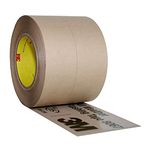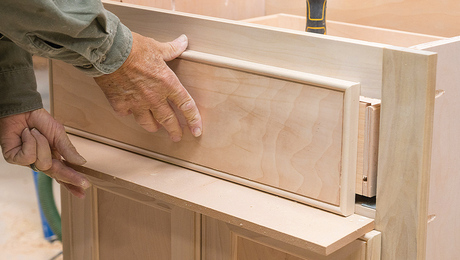Diamond wheels are dangerous
I couldn’t help noticing that Ms. Aeon, in her very fine article “Replacing a Broken Tile” (FHB #168, pp. 68-69), is using what appears to be a 41⁄2-in. DeWalt grinder to remove the tile. Be advised that DeWalt specifically warns against the use of the type-27 guard (the kind Ms. Aeon is using) when cutting with a diamond wheel. DeWalt makes a two-sided guard (the DW4705) that provides much better protection. Having witnessed a diamond wheel come apart at high speed, I personally recommend and use the DW4705.
—Larry Schuette, McLean, Va.
Conflicting views on sycamore’s nature
The sycamore vanity top on the back cover of the Kitchens & Baths issue (FHB #167) is pretty. However, the Forest Service Products Lab reports that sycamore moves a decent amount (as moisture changes) and is not durable. So won’t that pretty sycamore sunburst have joints opening and rot setting in a few years down the line?
—Bill Houghton, Sebastopol, Calif.
Kevin Wilkes replies: Our chief reference for such issues is Albert Constantine Jr.’s book Know Your Woods: A Complete Guide to Woods, Trees and Veneers (Scribner, 1987). He knows his stuff better than you and I. Mr. Constantine writes, “Sycamore, American (Platanus occidentalis) … The principal use of this wood is in the manufacture of lumber and veneer for decorative surfaces, but it is also used for railroad ties, fence posts and fuel. Because of its toughness, it is the favorite wood for butcher’s blocks.”
We installed that vanity in 1997, and the inset photograph published in FHB was taken in 2004, fully seven years after the vanity was installed. Has rot set in yet? Not that we can tell.
The radial sunburst pattern was laid up in small pieces, all quartersawn, and all joints were glued with type-II (waterproof) glue. The critical detail in handling the expansion/contraction issue relates to the cutting out of the center of the pattern. The inside and outside edges are free and unrestrained, therefore allowing for movement in the radial axis. We finished the top with McCloskey Man O’War Spar Varnish (Valspar Corp.; www.valspar.com).
A safer deicer
Here in northeastern Ohio, it’s almost gospel that salt eats concrete (FHB #168, “What’s the Difference?” p. 122). I’ve seen numerous instances of spalling surface damage after a short time where homeowners used salt on their walks. As a result, I’ve increased the bag mix in my exterior concrete specs in an attempt to protect customers from their own ignorance.
My experiences led me to try chemicals with a favorable effect on the vegetation and (I hope) a negligible effect on the concrete. The answer? Lawn fertilizer. It works. It’s not as aggressive as salt in penetrating the ice. But it has no detectable effect on the concrete’s surface, and it provides an added benefit to surrounding vegetation in the spring. I now recommend it to my customers.
—Jim McIntyre, Streetsboro, Ohio
Don’t cut trusses
Excellent article about roof-truss installations (FHB #168, “Rolling Roof Trusses,” pp. 94-99). But I wish to add a cautionary comment that trusses cannot be cut, drilled, notched, or modified in any way unless a structural engineer approves that alteration. Here’s a photo of an improper alteration from a three-year-old house that I inspected (left). The rough framing was inspected and approved by the city, and this web was altered by the furnace installer afterward. The tile roof was beginning to sag, and repair estimates started at $3,000.
—Joe Nernberg, Agoura Hills, Calif.
More door details, please
I want to comment on Scott McBride’s article “Custom Doors Done Easy” (FHB #168, pp. 86-89). I really liked the concept of the sandwich door; however, the article itself was somewhat lacking. It would have been much more helpful if dimensions had been given (door thickness, for example). I’m still trying to figure out if the middle section is 3⁄4 in. or 1 in. thick.
Also, it would have been better to go into more detail about setting the lockset. Photos are nice, but I’m always more interested in why and how a particular method was used.
—Dan Broadbelt, via email
Scott McBride replies: Yes, the middle layer of those doors is thicker: 7⁄8 in. for the middle vs. 11⁄16 in. for the outer layers. The 7⁄8-in. dimension allowed for a 3⁄16-in. lauan panel plus 11⁄16 in. for the beaded tongue-and-groove. The tongue-and-groove started as 3⁄4-in.-thick pressure-treated porch flooring, which has a rough surface, and planing it down to 11⁄16 in. improved the finish. Likewise, skinning 1⁄16 in. off the 3⁄4-in. stock for the outer layers allowed me to straighten and flatten it somewhat.
The total thickness of the sandwich is 21⁄4 in., which is the standard thickness for doors made of ten-quarter lumber. Finding a lock or deadbolt for doors thicker than 21⁄4 in. can be problematic.
Another factor driving the thickness of the middle layer was the thickness of the mortise lock, which in this case required a 7⁄8-in.-wide mortise. If the lock is thicker than the middle layer, it becomes necessary to rout shallow recesses in the outer layers before assembly, but that’s still easier than chopping a lock mortise from scratch.
Says truss article is out of touch
Regarding Larry Haun’s article “Rolling Roof Trusses” (FHB #168, pp. 94-99), you people must be completely out of touch with the real world. You are assuming that factory-built trusses come uniform and with precut rafter tails. In reality, most factory-built trusses are made with wild overhang tails and are cut on the job. In about an hour, two people can snap a line and cut off the rafter tails in a straight line for the fascia.
Using your method would take much longer and would not result in a straight fascia.
—Michael Walter, Gardnerville, Nev.
Larry Haun replies: If your trusses come with “wild overhang tails,” then you have to snap lines for your overhang, mark the plumb cut, and make the cuts. Until the past few years, I used this method. In fact, I describe it in my book The Very Efficient Carpenter (The Taunton Press, 1992).
The trusses I’ve been using in California and Oregon for the past 10 years are made in a jig and are accurate. We specify the length of the tails, and they are all precut. We use the method that I explained in the article and come up with a straight fascia.
Debating receptacles in baseboards
In your October/November issue (FHB #166, p. 10), Timothy P. Cleary suggests placing an electrical outlet in the baseboard of the home shown on the cover of FHB #165 to improve aesthetics. I agree that it might look better, but only at the cost of functionality and possibly code conformity. Outlets placed close to the floor are inconvenient to reach for able-bodied adults, and impossible for those who use a wheelchair or cannot bend easily (e.g., the elderly). Check your local electrical code, but 16 in. above the finished floor gets the job done at my house.
—Dave M. Wackerlin, Brampton, Ont., Canada
Lynn Underwood, a building official in Norfolk, Va., replies: You certainly have a point with regards to accessibility for the physically impaired, but I know of no code requirement in the United States that would prevent an outlet from being installed in a baseboard. Likewise, there is no requirement for height above finished floor. In fact, outlets are regularly installed in floors as well. There is only one caveat about outlets in a baseboard: Either the box extends so as to be flush with the face of the baseboard (Article 370-20 of the National Electrical Code), or if there is an opening, an extension must be used to abate the gap (Article 370-22). The latter is regarded as an arc shield. It can be a plastic ring that extends the box to the flush surface.
Breakfast-nook length
Regarding Sarah Susanka’s “Drawing Board” column “Designing a breakfast nook” (FHB #167, pp. 124, 126, 128), what is a comfortable length for the six-person table shown with the L-shaped booth on p. 128? I’m remodeling my small kitchen and hope I can fit in a six-person booth. If not, I’ll have to make it for four.
—Louis Maffei, via email
Sarah Susanka replies: I use 72 in. as the norm, but I have designed a breakfast nook with a table that extends to 108 in., where the benches act as extra seating spacewhen the table is not extended.
Erratum: Drawer slides
On p. 108 of the Kitchens & Baths issue (FHB #167), Tony O’Malley explained the difference between epoxy-coated utility drawer slides, stainless-steel ball-bearing drawer slides, and undermount drawer slides. Due to an editing error, the utilityslide lengths were mislabeled. Full-extension and three-quarter-extension drawer slides are commonly available. But to the best of our knowledge, there is no such thing as a “half-extension slide.”
Fine Homebuilding Recommended Products
Fine Homebuilding receives a commission for items purchased through links on this site, including Amazon Associates and other affiliate advertising programs.

8067 All-Weather Flashing Tape

Reliable Crimp Connectors

Handy Heat Gun






















